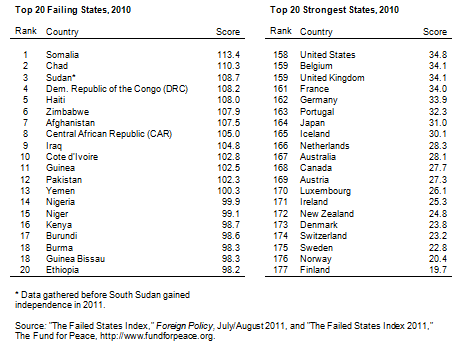After a half-century of forming new states from former colonies and from the breakup of the Soviet Union, the international community is today faced with the opposite situation: the disintegration of states. Failing states are now a prominent feature of the international political landscape.
The most systematic ongoing effort to analyze countries’ vulnerability to failure is one undertaken by the Fund for Peace and published in each July/August issue of Foreign Policy. The research team analyzes 177 countries and ranks them according to “their vulnerability to violent internal conflict and societal deterioration,” based on 12 social, economic, and political indicators. Each indicator is scored from 0 to 10. A combined score of 120 would mean that a society is failing totally by every measure. Somalia, the country first on the list, scores 113.4. A score of 0 is the strongest score possible. Finland, number 177 on the list, is the strongest state with a score of 19.7.
Comparing the weakest states and strongest states reveals that rankings on the Failed States Index are closely linked with demographic indicators.
Women tend to have the most children where they lack access to family planning and where girls are not enrolled in school, as is the case in many of the top failing states. In Yemen, which has a fertility rate over 5 children per woman, 51 percent of married women have an unmet need for family planning—the highest rate in the world. One third of Yemen’s girls are not enrolled in primary school, among the lowest enrollment rates in the world. In contrast, the top strong states have low fertility rates, many falling below 2 children per woman. More
